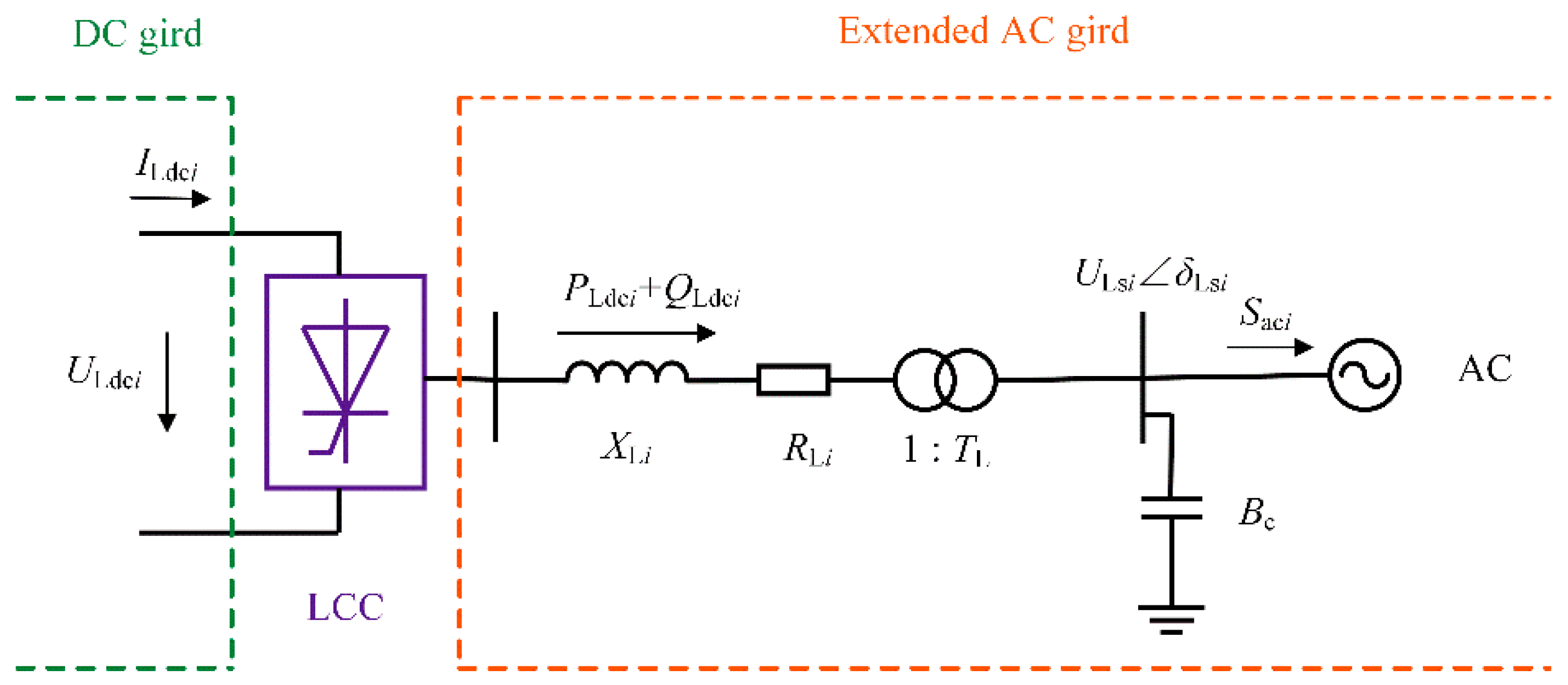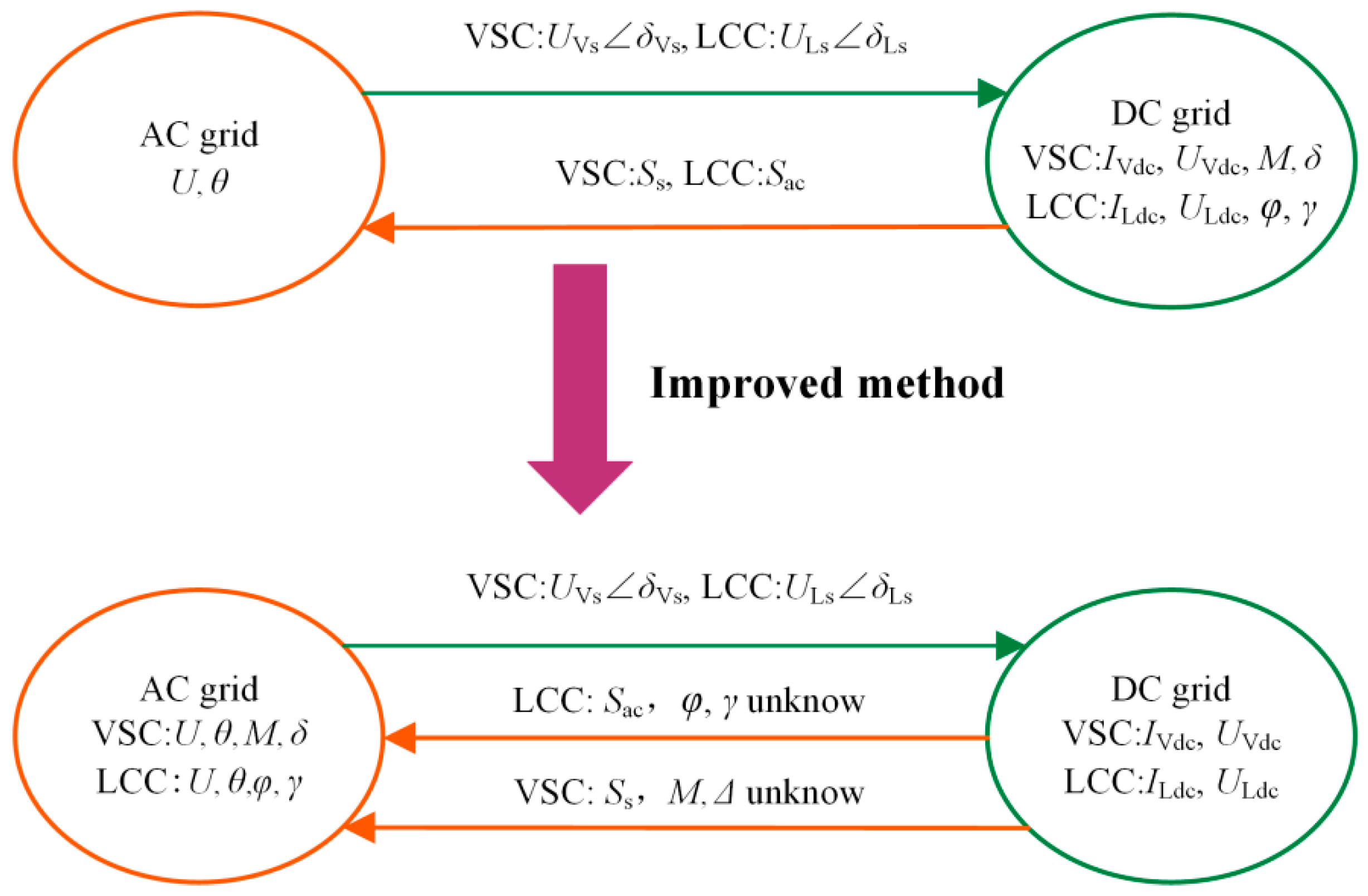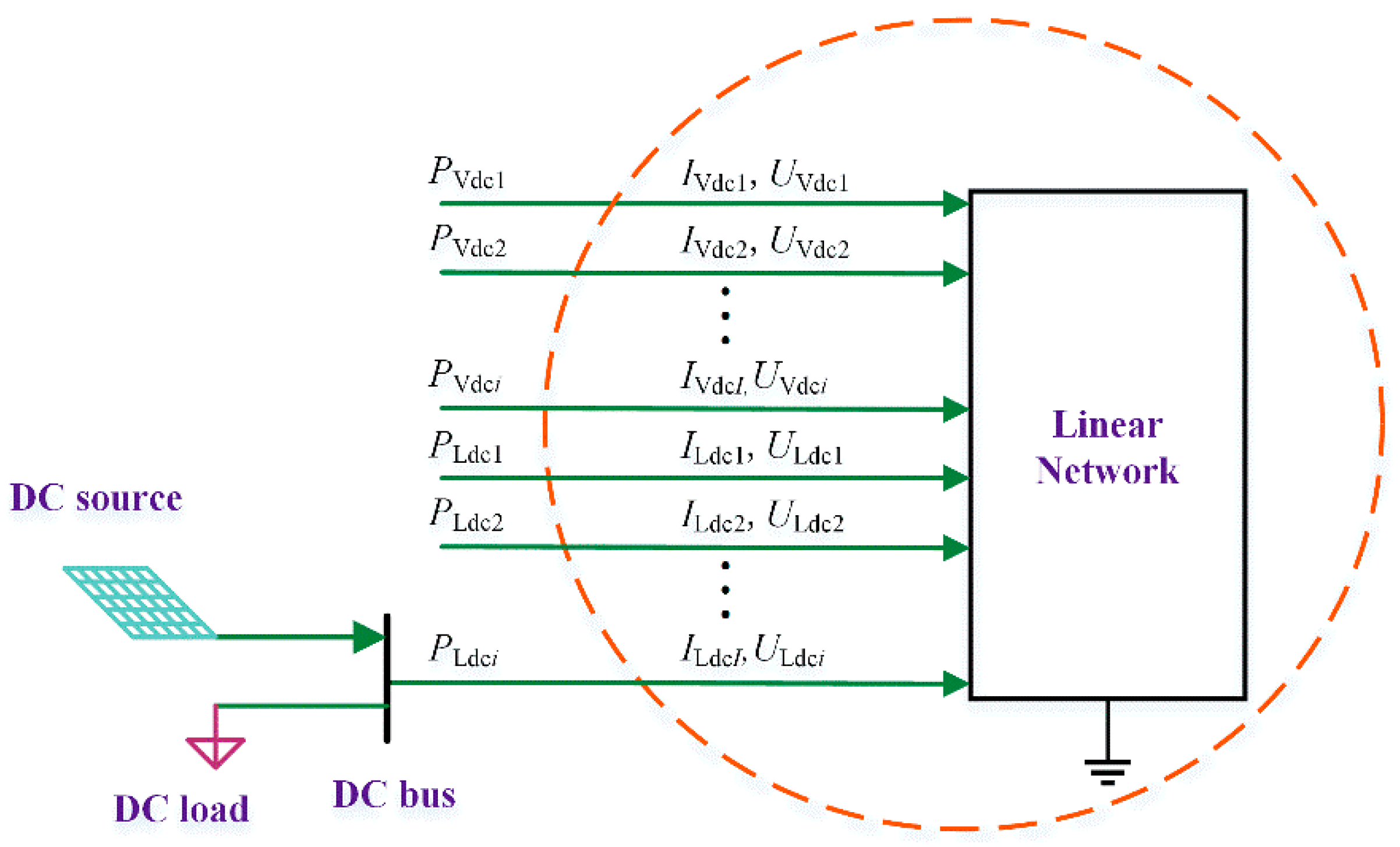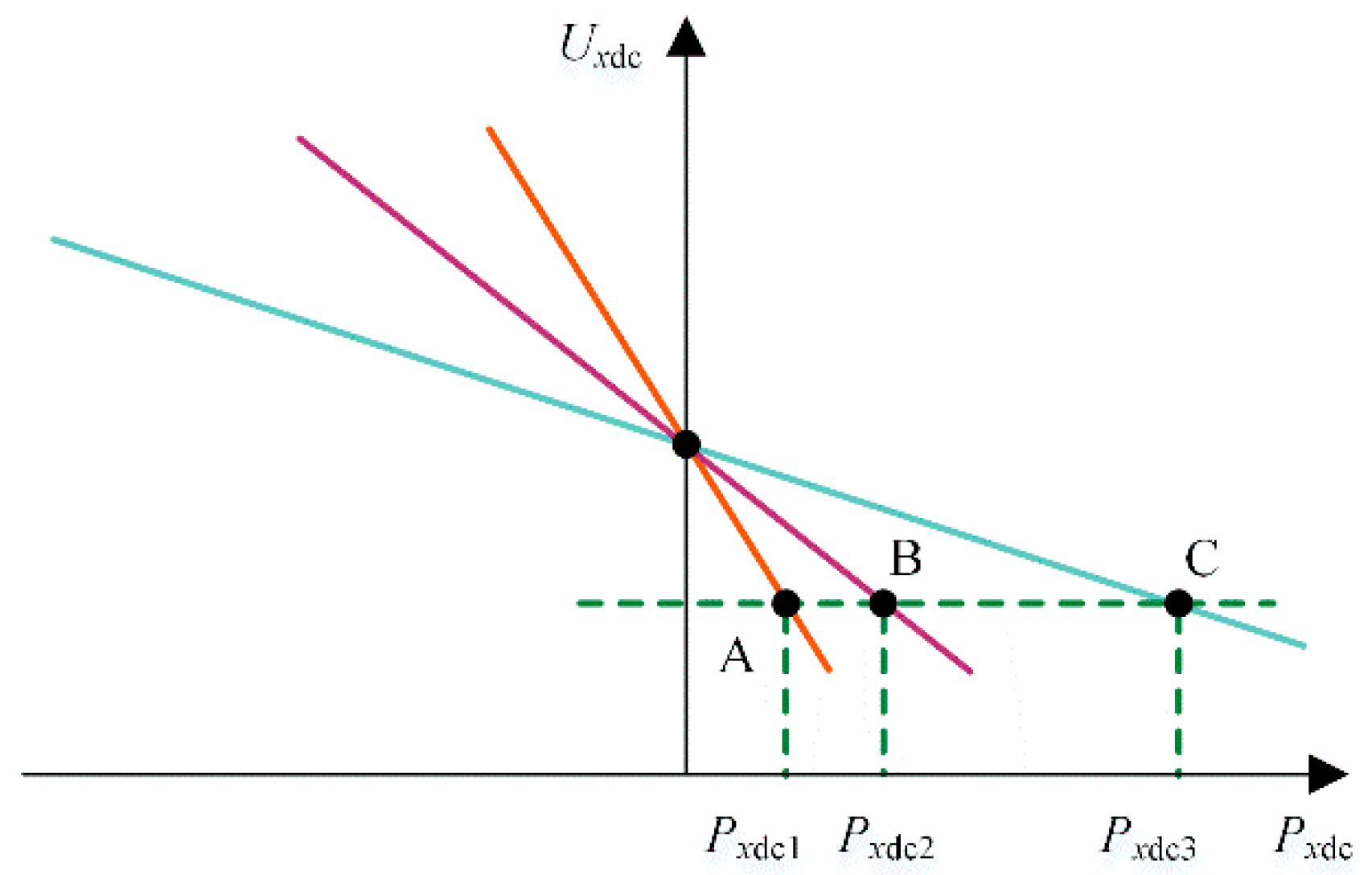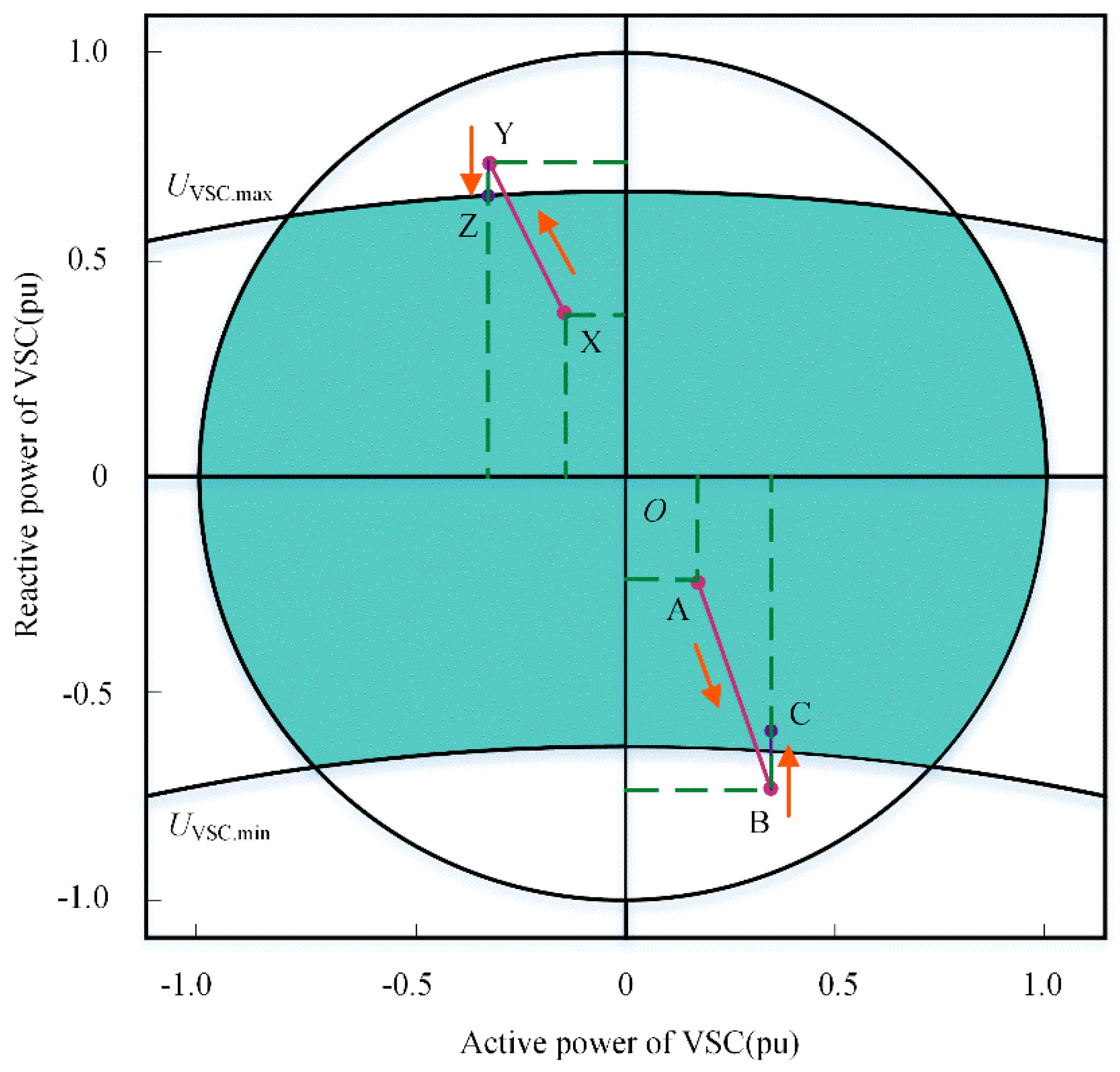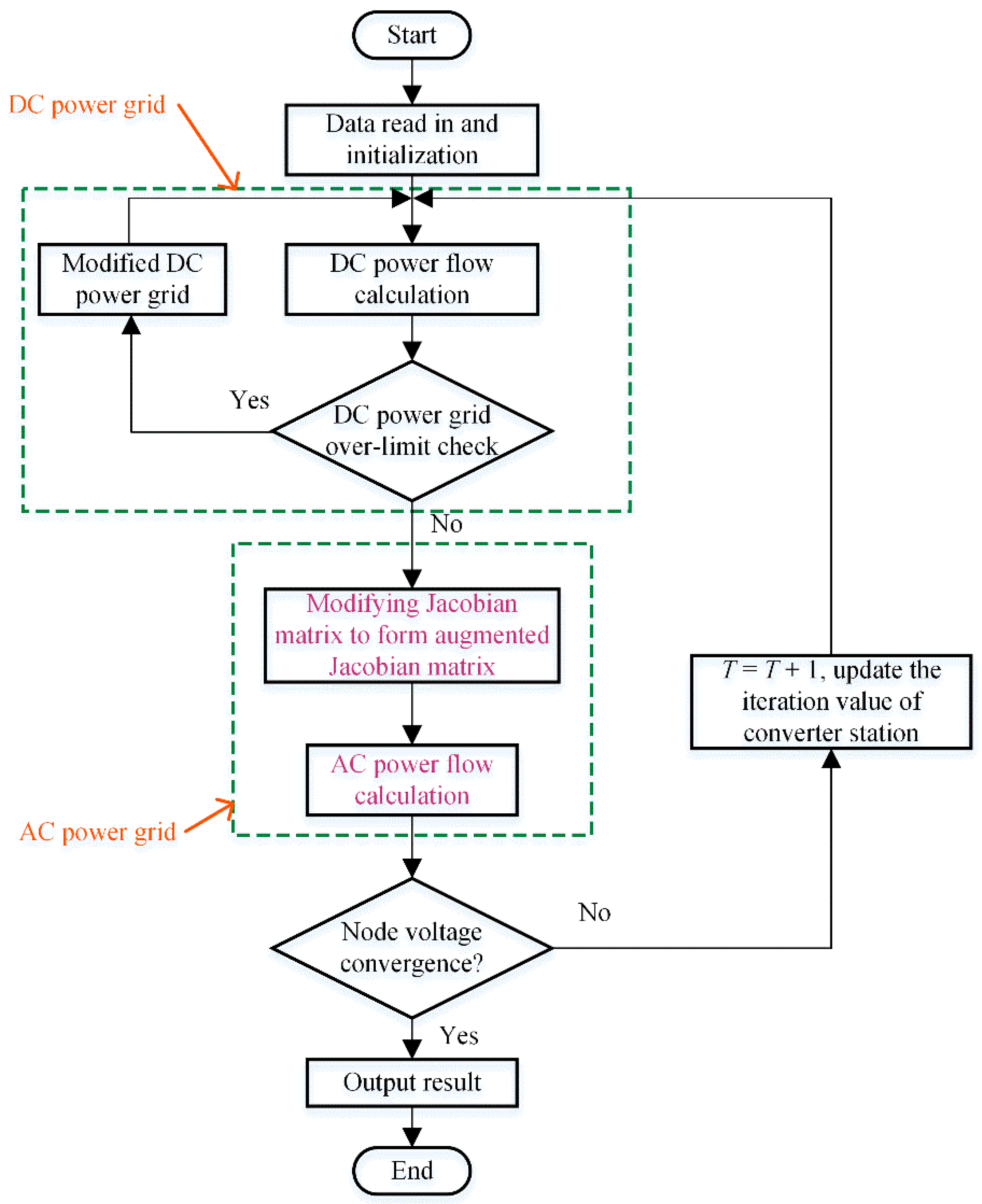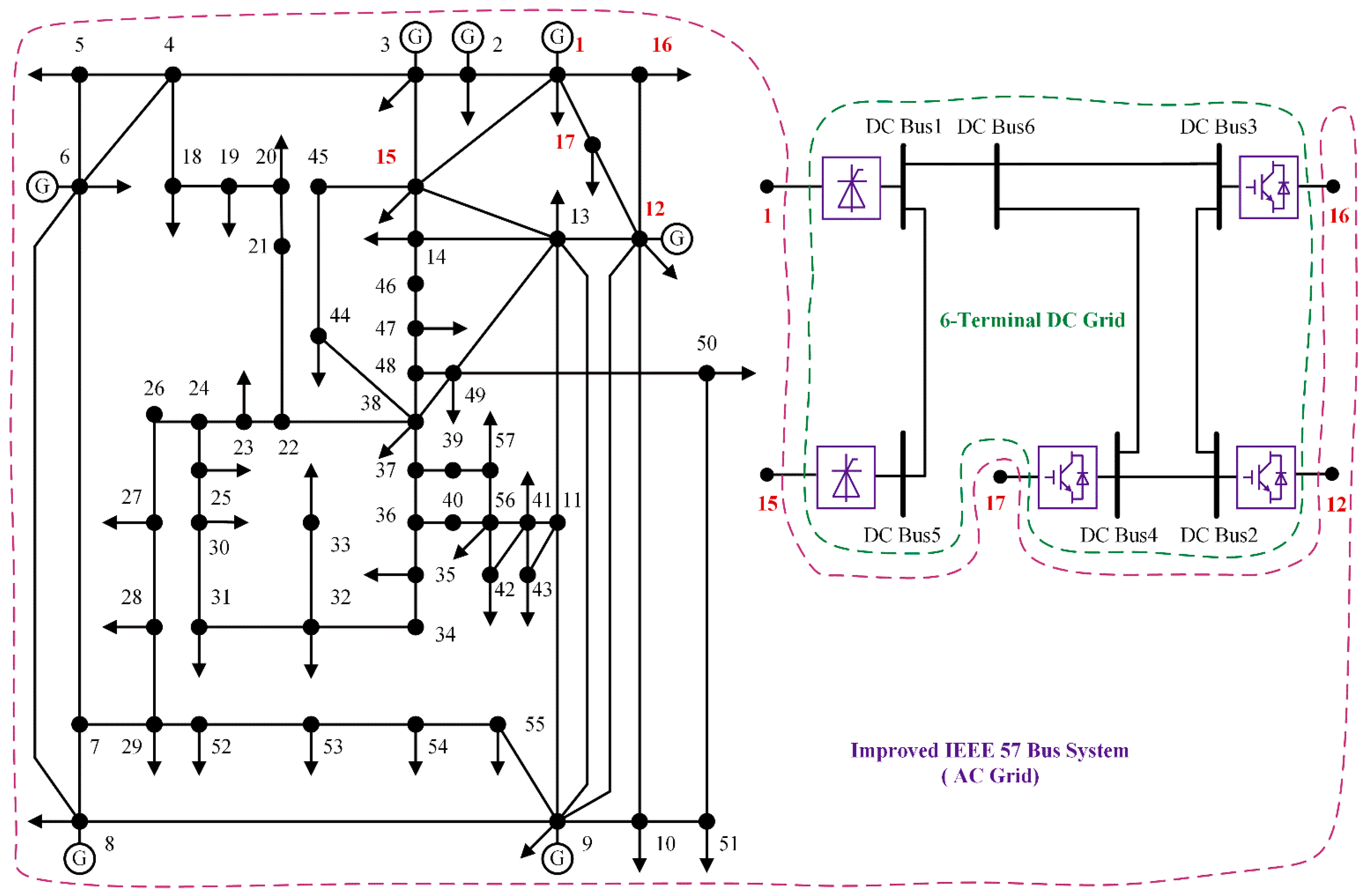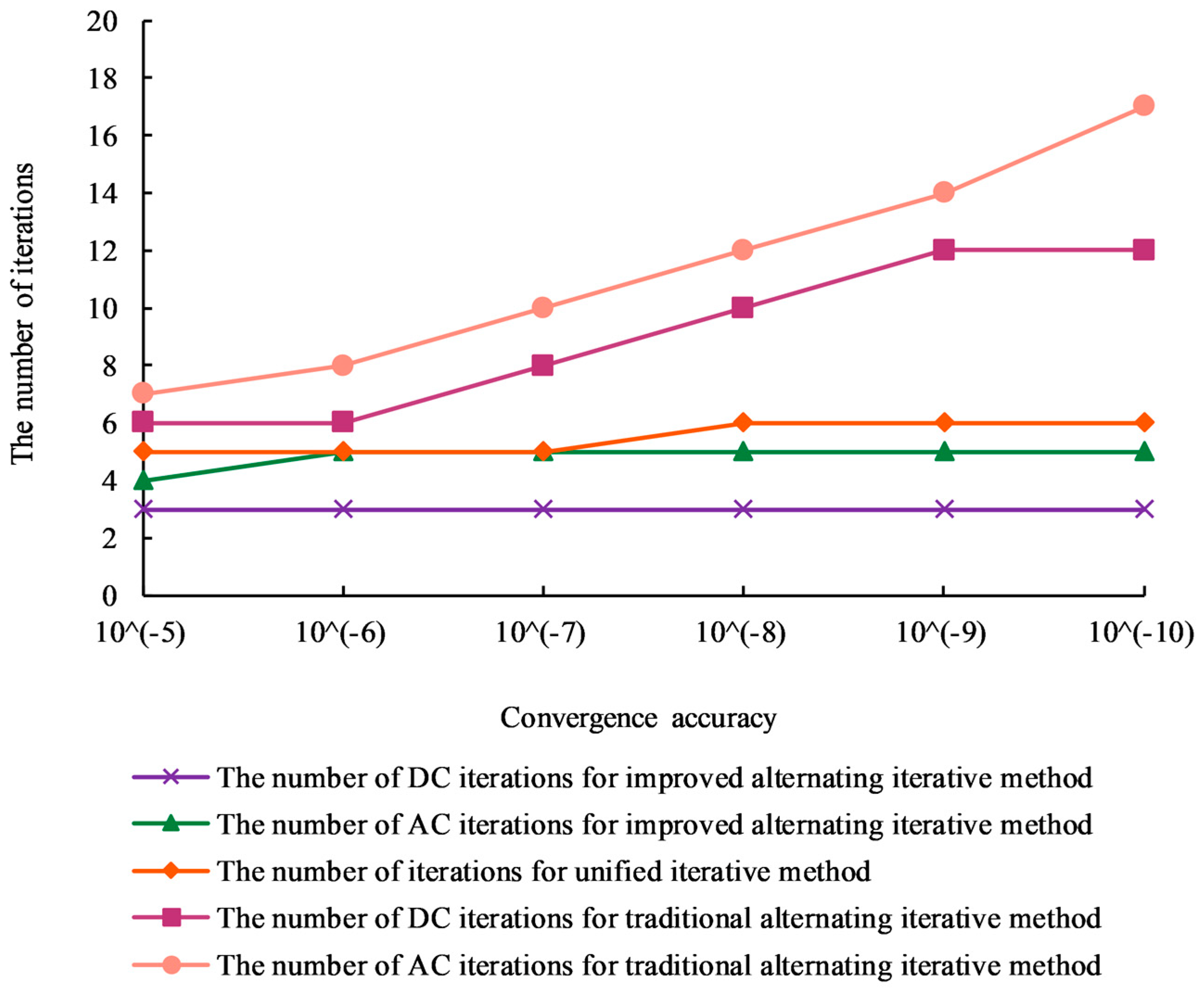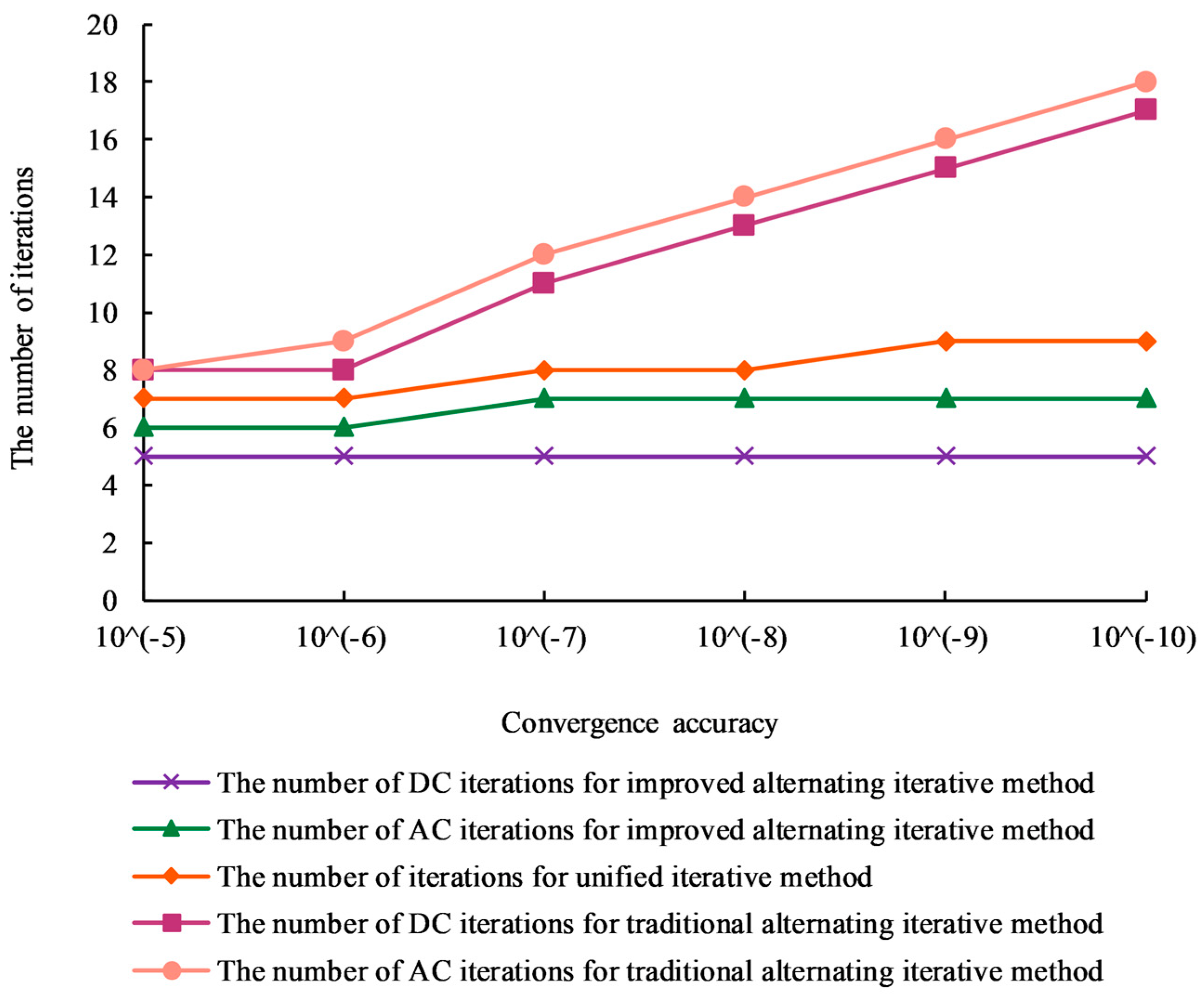1. Introduction
A hybrid AC–DC transmission system consisting of a line-commutated converter (LCC)/voltage source converter (VSC) and AC grid is likely to become an important transmission method in the future [
1,
2,
3]. With the increasing scale of the DC grid, the non-linear discrete control process of the DC grid changes the dynamic characteristics of the AC grid, and the difficulty of operation control increases sharply [
4,
5]. At the same time, the vulnerability of the DC grid to faults has also changed the scope of fault impact and put forward new requirements for relevant stability and recovery-control technology [
6,
7]. In addition, power-flow analysis is an important premise and foundation when analyzing the steady and transient operation of AC–DC power grids, while designing the corresponding control modes [
8,
9,
10]. To meet this need, in our paper, by incorporating the converter interface model into the AC side, we propose an alternating iterative power-flow algorithm for hybrid AC–DC power grids incorporating LCCs and VSCs, consider the interaction between the DC side and the AC side, and establish an augmented-exchange Jacobian matrix model with LCC/VSC interface equation variables.
In recent years, extensive research efforts have been carried out on AC–DC power-flow calculation methods to support the increasing scale of DC grids [
11,
12,
13]. Hybrid AC–DC power-flow calculation methods can be divided into two categories: unified solution methods and alternating solution methods [
14,
15]. Unified solution methods have satisfactory convergence, and the number of iterations is small. However, the program inheritance is poor [
16,
17]. As the size of the DC grid increases, so does the computational complexity, resulting in a decrease in iteration speed [
18]. The alternating iteration method has the advantages of fast calculation speed, strong program inheritance, and convenient control-mode switching [
19,
20,
21]. However, it has high requirements for the initial value of the AC grid and poor convergence. In response to these problems, scholars have conducted research [
22,
23,
24,
25,
26]. An alternative solution approach is proposed to solve the multi-terminal VSC-HVDC power-flow problem [
22,
23]. This is a full VSC-HVDC power-flow solution, but the strong convergence characteristics of the Newton–Raphson method are sacrificed due to the sequential iterative solution adopted. Authors of [
24] present a new model of VSC-HVDC aimed at power-flow solutions using the Newton–Raphson method. Due to its pure AC–DC grid decomposition, the simplification of elements within the converter stations is not required. In [
25], based on typical three- and five-terminal DC grids, the nodal admittance matrix-based Gauss–Seidel method and the nodal impedance matrix-based Gauss–Seidel method were investigated and compared for a DC grid power-flow calculation. Authors of [
26] analyzed the reasons for repeated alternating and proposed an AC–DC decoupled hybrid power-flow algorithm for a hybrid power system with VSC.
The open-source program MatACDC is based on VSC-HVDC for a power-flow calculation of an AC–DC hybrid system [
27]. This program is based on the Matpower program for AC power-flow calculation and is used to calculate the conventional power flow of the hybrid system. MatACDC uses a sequential AC–DC power-flow routine to solve the network. The traditional sequential methods need many alternative iterations and have convergence problems. In order to overcome the shortcomings of these two types of method, researchers have also achieved some results in this area. In [
28], a general alternating iterative AC–DC power-flow method is proposed, which is based on the decoupled equivalence of different control methods of a VSC on the AC and the DC sides. It avoids the repeated alternation process and reduces the total calculation amount by adjusting the control parameter of a VSC and the dividing line between AC and DC subsystems. When the AC side is a radial distribution network, the convergence of the calculation becomes poor when using the forward backpropagation method for the AC-side power-flow calculation; this is the next problem to be investigated and solved by this AC–DC decoupling power-flow algorithm.
Table 1 includes the main features of the literature on AC–DC power-flow calculations. Nevertheless, the latest research still has limitations in two aspects: (1) In traditional alternating iterations, due to the poor coupling between AC and DC, multiple iterations are required to realize the convergence of the power-flow calculation results. With the increasing scale of the DC grid, this problem will be more prominent. (2) VSC and LCC differ significantly in terms of control modes. The two power-flow calculation models and their algorithms are not universal. In AC–DC power-flow calculations with a VSC, the characteristics of the loss of the VSC, various control strategies of the DC grid, and efficient calculation methods under various control modes must be considered. In addition, in the calculation of AC–DC power flow with an LCC, the coupling relationship between the DC state variable and the AC side must be considered. The main aims of this paper are follows: based on the traditional alternating iterative method, this paper incorporates the converter interface model into the AC side, considers the interaction between the DC side and AC side, and establishes an augmented-exchange Jacobian matrix model with LCC/VSC interface equation variables. According to the type of converter, the control mode, and the DC grid strategy, a DC grid power-flow calculation model under various control modes is established for realizing the AC–DC power-flow decoupling calculation with LCC/VSC. The improved algorithm is applicable to various types of converter, various converter control modes, various DC grid control modes, and reasonable adjustments of the DC grid variable constraints and operation modes. The algorithm reduces the calculational burden for the DC power flow, especially for the calculation of AC–DC power flow with many DC nodes, which can effectively reduce the number of iterations. Therefore, the main contributions of this work can be summarized as follows:
The proposed algorithm considers the characteristics of the loss of a VSC, various control strategies of a DC grid, efficient calculation methods under various control modes, and the coupling relationship between the DC state variable and the AC side.
The proposed power-flow calculation algorithm for AC and DC grids with LCC and VSC is applicable to various DC grid control modes and considers the reasonable adjustment of DC grid variable constraints and operating modes.
The proposed DC grid power-flow calculation model under various control modes is established to realize an AC/DC power-flow decoupling calculation with LCC/VSC.
The augmented Jacobian matrix model with LCC/VSC interface equation variables can reduce the dimension of the DC Jacobian matrix, and the number of iterations is significantly reduced.
Table 1.
The main features of the literature on AC–DC power-flow calculation.
Table 1.
The main features of the literature on AC–DC power-flow calculation.
| Literature | Methods | Interaction Effects | Converter Types | Control Modes | Computational Efficiency |
|---|
| Ref. [12] | Holomorphic embedding | Not considered | VSC AC/DC systems | Can accommodate various control modes | Can save both time and storage |
| Ref. [13] | Alternating iterative | Not considered | VSC AC/DC systems | Not considered | Ensures the convergence of NR algorithm |
| Ref. [16] | Unified iterative | Not considered | VSC AC/DC systems | Different control modes are set for the converter | Greatly shortens the calculation time |
| Ref. [21] | Alternating iterative | Not considered | VSC AC/DC systems | Not considered | Improves the power-flow calculation speed |
| Ref. [22] | Alternating iterative | Not considered | LCC AC/DC systems | Not considered | Integrates with existing AC power-flow algorithms |
| Ref. [23] | Alternating iterative | Not considered | LCC AC/DC systems | Not considered | Provides accurate and reliable results for practical applications |
| Ref. [24] | Alternating iterative | Not considered | VSC AC/DC systems | Not considered | Can reduce the number of iterations |
| Ref. [26] | Alternating iterative | Not considered | VSC AC/DC systems | Considers converter control methods | Reduces the total calculation amount |
| Ref. [27] | Alternating iterative | Considers the constraints between the AC and DC grid | VSC AC/DC systems | Considers variety of converter control strategies | Provides a user flexibility to define the AC and HVDC |
| Ref. [28] | Alternating iterative | Not considered | VSC AC/DC systems | The control mode of VSC is analyzed | Avoids the repeated alternation process and reduces the total calculation amount |
| This paper | Alternating iterative | Considers the interaction between the DC side and AC side | VSC-LCC AC/DC systems | The DC power-flow calculation under various control modes is established | Especially with many DC nodes, which can effectively reduce the number of iterations |
The remainder of this paper is organized as follows:
Section 2.1 introduces the converter station model.
Section 2.2 introduces the improvement of the alternating iteration method for AC–DC power-flow calculation.
Section 3 provides the solution methodology of our model. In
Section 4, a modified IEEE 57 bus system with six terminals of DC power grids and the CIGRE B4 bus system are simulated in MATLAB, and the numerical results are discussed.
Section 5 concludes this study.
4. Results and Discussion
The traditional alternating iteration method and the method in this paper are applied to case 1. The results of the two algorithms are compared in
Table 9. The maximum error of all state variables in the AC–DC power grid is 7.9 × 10
−5; the improved alternating iteration algorithm in this paper is accurate.
In reference [
45], a hybrid AC–DC power-flow alternative iterative algorithm is proposed to solve the current difficulties in the power-flow calculation of LCC–VSC hybrid DC transmission systems. However, the initial value should be reasonably selected to ensure power-flow convergence and accurate results.
Figure 10 compares three methods: the method that is proposed in this paper, the traditional alternating iteration method, and the unified iteration method. The number of DC power-flow iterations, the number of AC power-flow iterations, and number of iterations of the improved alternating iterative method are all less than those of the traditional alternating iterative method. Moreover, the improved method is not sensitive to an increase in the convergence precision: the number of iterations remains approximately unchanged. The number of iterations increases linearly with the convergence precision. Compared with the unified iterative method, the method has similar convergence, and the number of iterations does not increase linearly with the accuracy.
Considering the convergence accuracy of 10
−7 as an example, the differences in the Jacobian matrix dimension, the number of iterations, and the calculation time between the traditional AC–DC power-flow algorithm and the proposed algorithm are examined. The results are presented in
Table 10. According to the table, for case 1, the dimension of the DC Jacobian matrix is reduced by 18 compared with the traditional alternating iteration method. All three methods can converge. Under the same convergence accuracy, the difference in the number of iterations is substantial. The method that is proposed in this paper has the advantages of the unified iteration method in terms of the number of iterations and the convergence speed.
In the power-flow calculation results, the voltage, current, and power of the AC grid are within reasonable ranges. The power flow of the converter station accurately tracks the reference value. The power-flow calculation results of the DC power grid are presented in detail in
Table 11, in which the DC voltage and the DC power of DC node 1 and DC node 2 satisfy the droop control characteristics.
If the DC power of DC bus 3 is increased to 0.7, the DC powers of DC bus 1 and DC bus 2 are 0.7013 and 0.9573, respectively, while the original drooping coefficient of the converter station is unchanged. At this time, the voltages of DC bus 1 and DC bus 2 are 0.9903 and 0.9933, respectively. By changing the drooping coefficient, the original drooping coefficients of DC bus 1 and DC bus 2 are reduced by 0.02 and increased by 0.02, respectively. The powers of the DC buses are 0.5027 and 1.0520, and the DC voltages are 0.9909 and 0.9989. The above conditions all satisfy the droop control requirements.
The calculation results demonstrate that the improved alternating iterative method is suitable for single-point voltage control and multipoint voltage droop control and can accurately calculate AC–DC power flow. For the control methods of multipoint voltage control and voltage droop control with a dead zone, the improved method of this paper is still suitable.
The CIGRE B4 node system has 11 AC buses and 14 DC buses. Compared with other DC bus systems, it has more DC buses; hence, it is more suitable for analyzing the improved AC–DC calculation method.
Figure 11 compares the proposed method, the traditional alternating iteration method, and the unified iteration method in terms of the number of iterations. With an increase in the number of DC buses, the number of iterations of the improved alternating iterative method does not increase significantly. In contrast, the number of iterations of the traditional alternating iteration method and the unified iteration method increases substantially. Moreover, under the proposed method, with an increase in the convergence precision, the number of iterations remains approximately unchanged. Under the traditional iteration method, with an increase in convergence accuracy, the number of iterations increases more substantially.
Similarly, the convergence accuracy of 10
−7 is considered as an example to illustrate the differences between the traditional AC–DC power-flow algorithm and the proposed algorithm in terms of the Jacobian matrix dimension, the number of iterations, and the calculation time. The results are presented in
Table 12. Compared with the traditional alternating iteration method, the dimensions of the DC Jacobian matrix in case 3 are reduced by 45 and the number of iterations is significantly reduced.

